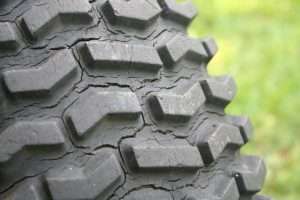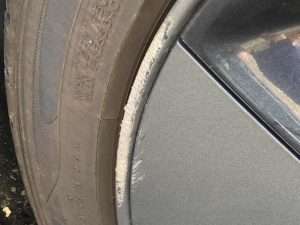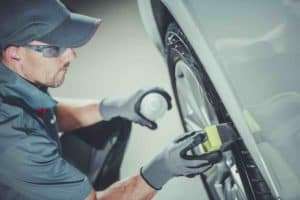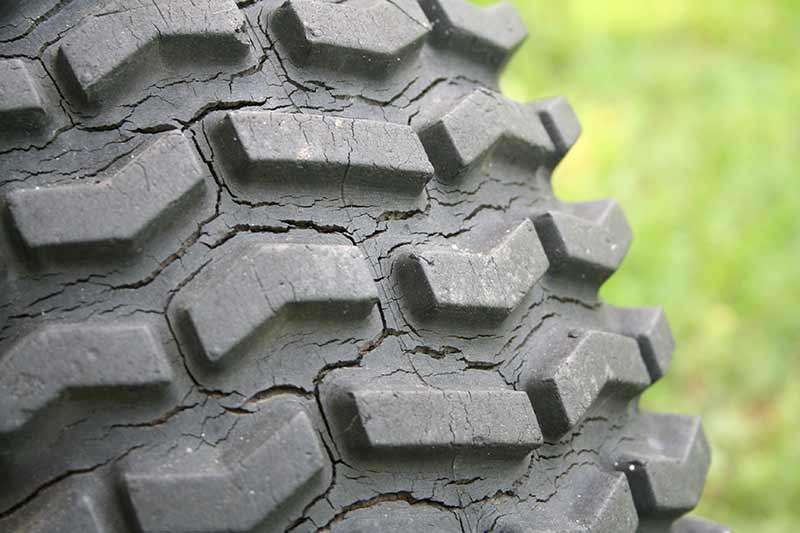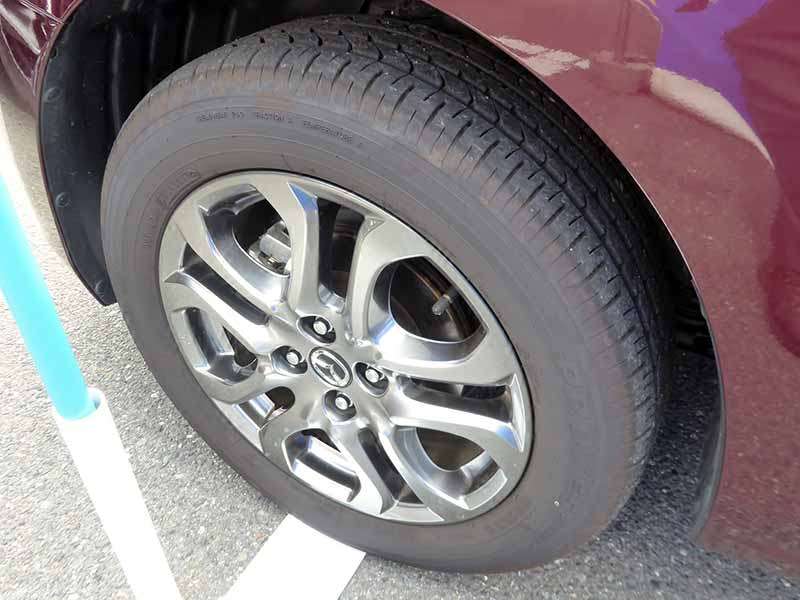Table of Contents
Have you heard negative things about tire shine?
There are a lot of myths surrounding this useful product, some of which may seem plausible. After all, we’re talking about your vehicle, the means to get to wherever you want to go. It’s good to be cautious, especially when you and your family’s safety is involved.
So, is tire shine really bad for your tires? The short answer is: No.
Tire shine is an automotive detailing product that’s been used for many years. Manufactured by a variety of companies and used in dealerships all across the globe, tire shine works with your rubber to restore it, not destroy it. In fact, there are many benefits to using tire shine.
In this article, we’ll introduce you to tire shine and instruct you in how it is applied. We’ll walk you through the different types of tire shine and what benefits each type has. Then, it’s time to deal with those tire shine myths. Which ones are true? What myths do you believe? All your tire shine questions should be answered below.
Less talk, more shine. Tire shine, that is.
Is Tire Shine Bad For Tires?
No. Tire shine works with your rubber to restore it, not destroy it. In fact, there are many benefits to using tire shine. Aside from the obvious aesthetic benefits, quality tire shine products help protect the rubber from harmful UV rays from the sun, provide protection from road contaminants, slows dry rot, and will slow tire blooming.
What is Tire Shine
Driving on any road can discolor the surface of the tire that surrounds the wheel. Dirt, debris, water, and many other contaminants stick to the rubber of the tire. These foreign objects can blemish the surface, making the tire look like it’s in worse condition than it is. Tires can also experience cracking or may be brown in color.
Tire shine (and a good wash) take care of these blemishes.
Tire shine, tire dressing, or tire coating is simply a product applied to the outer-facing side of tires. This product makes the tire appear to be wet or glossy. A tire dressing’s main task is to improve the appearance of the tire, as well as protect it from road contaminants, dry rot, cracking, blooming/browning, and any other issues a tire may experience.
The best tire shine is the one that is easiest to apply and comes off well when washed. At the same time, quality formulas may cost more but are worth the extra penny for sure. Let’s dig a bit deeper into what types of tire dressings are out there and what you can expect from each type.
Types Of Tire Shines
Tire Shine Spray Vs Gel Vs Coating
Spray Tire Shine
Liquid spray tire shine is easier to apply since it is better able to get into details in the tire sidewall. In addition to being easier to apply, it usually will look more uniform. Sprays being liquid tend to have less staying power and wash away quickly.
303 Aerospace Protectant
While it isn’t specifically designed to only be used on tires, I really like 303 spray protectant. It’s an excellent UV protectant that is great for protecting rubber and it is dry to the touch.
My favorite part is the matte black finish that it leaves. I’m not a fan of shiny tire protectants like those from Armor All and several other manufacturers.
Like most spray rubber protectants, it doesn’t last long exposed to rain and other harsh weather unfortunately.

Meguiar’s Hyper Dressing
Hyper Dressing is extremely versatile alternative to 303.
It is shiny in full strength but can be diluted for a matte sheen. Hyper dressing looks great but doesn’t last in the rain. If durability is what you want, you’ll need to consider a gel or coating.

Gel Tire Shine
A thicker gel-based tire shine usually will better withstand a rainstorm or car wash than a spray-on dressing. The downside with the thicker consistency is it can be slightly more tricky to ensure that small details in the sidewall are properly coated. You’ll also need to spend more time ensuring the application is uniform to get the best appearance and protection.
Meguiar’s Endurance Tire Gel
Tire gels tend to be a little more long-lasting than tire shines due to their thicker consistency. They won’t last as long as a tire coating but they typically won’t wear off after the first rain either.

Tire Coatings
Tire coatings are a completely different formulation that will leave an extremely durable protective coating on top of the rubber. They provide all of the benefits of tire shine but can last a year or more in some cases. They do require proper cleaning and prep of the rubber prior to application however.
McKee’s 37 Tire Coating Kit
Extremely long-lasting tire coatings are my personal favorite. They last months instead of days and look great. Plus they give superior protection to the tire rubber. The best choice IMHO.

Different Kinds of Tire Shine Products
Head down to your local automotive store and you’ll probably see quite a few tire dressing products lined up on the shelves. How do you differentiate between them, and more importantly, which product is going to be the best for your situation?
You can break down any tire dressing product based on who makes it, what form it comes in, and what sort of chemical makeup it has. Don’t worry, you won’t need to know chemistry to make your tires look great.
Manufacturer
If you’ve done any sort of DIY cleaning, detailing, buffing, or whatever else it might be to your vehicle, you probably have heard of big names like Meguiar’s, Chemical Guys, Mother’s, etc. These are the brands typically stocking the aftermarket product aisle with all kinds of pastes, waxes, bars, soaps, compounds, and more.
One way to choose between tire dressing products is to go with a brand you trust. If you’ve used Mother’s polish to keep your chrome and exhaust tips shiny, check out their tire dressing products. Armor All is oftentimes a more affordable option, but that’s not to say any other brand won’t bring the gloss factor to your tires.
If you don’t have loyalty to a particular brand, experiment! There’s nothing wrong with choosing something that catches your eye because you’ll find out soon enough whether or not it’s a product you’ll buy again.
Formulas
All brands aside, choosing a tire shine product can also be done another way: formula. We’ll talk about the chemical makeup in a minute, but looking at how the dressing itself meets the tire can do a lot to narrow down your choices.
For example, tire shine products come in a number of forms or consistencies. You can choose from solvents, sprays, aerosols, gels, foams, concentrates, etc. Aerosols and foams are often easiest for most people to apply since they work like most spray paints via a depressible nozzle. Gels go on with an applicator. We’ll go more into detail later about the application, but you get the point.
Different brands will choose to produce their tire shines in select forms. Depending on which type of formula you prefer, you may choose to go with a brand you haven’t tried before. The best thing to do is to try out a few different products and see which one fits your needs.
Chemical Composition
There are two main types of tire shine: water- and silicone-based. Both types will give your tires the shine you’re looking for but in different ways.
For example, water-based tire shine is typically comprised of the actual shine product diluted in water. The product transfers from the spray bottle to the tire via water droplets. You can easily mix water-based tire shine to be less or more shiny, depending on what you’re looking for.
Silicone-based tire dressings, in a similar way, use silicone to transfer the shine. If you’re using a silicone-based tire coating, there’s no dilution involved. The product goes straight from the spray bottle to the tires. Tire coatings based on silicone oftentimes produce a higher gloss than most water-based equivalents.
The biggest difference between water- and silicone-based tire dressing products lies in how you remove them. Removing water-based tire shine is as easy as washing your wheels and tires with soapy water, just as you cleaned them before applying this type of tire shine. Silicone-based shines will require a degreaser to remove.
How to Apply Tire Shine
The actual application of tire dressing doesn’t take much effort. However, there are a few preparatory steps to get the most out of your tire dressing product.
Washing Your Vehicle
The first step in applying tire shine is to clean the tire itself, as well as the wheel. Simply washing the wheels and tires with water is sufficient, but it’s best if you use a degreaser or a wheel-and-tire-cleaning product dedicated to this task.
Whether you prefer to wash your vehicle yourself or want to run it through your favorite car wash, you should ensure the wheels, tires, and most importantly the wheel wells are thoroughly cleaned. Any grime that’s in the wheel wells can drip down on your tire, ruining any glossy effect the tire shine may provide.
After the tires are clean, wait a few minutes for the rubber to dry off. Now you’re ready to apply tire shine.

Choose Your Application Method
There’s more than one way to apply tire shine. Really, it depends on the tire shine products you choose, specifically the formula.Spray Bottle Tire Shines
If you chose a spray or misting tire dressing, the application process is rather easy. Turning the nozzle to the appropriate spray pattern, follow the circular direction of the tire as you spray the outer-facing surface. This extends from the tops of the tires where the tread starts to the inner diameter where it meets the wheel. You may need to use a few sprays to completely cover the tire. Best practices when using spray bottle tire shines include keeping the bottle upright, overlapping your sprays, and being careful not to spray the tire shine too thick. This will cause the product to drip down on your rims and requires more work to remove.Aerosol and Foam Tire Dressings
Sometimes messing with a spray bottle and trigger can be a hassle. If you prefer to use less finger strength but want similar results, aerosol and foam tire dressings are a great alternative. To use foam dressings, simply cover the entire outer surface of the tire with the foaming product. Let it sit for a few minutes and once the foam is gone, it should leave behind a sleek, glossy finish. Aerosol dressings work in a similar way, just without the foaming action.Gel-Based Tire Dressing
Working with tire shine gel can be an interesting experience. Typically, gel shines are concentrated so you get the most out of your tire shine product. You’ll be able to use less product and it should go further as well. You’ll need an applicator to apply gel tire dressings. These applicators typically follow the curve of the tire and resemble a foam pad or sponge, sometimes with a handle attached. To apply the tire shine, measure out a small amount of gel on the applicator and begin wiping the tire. You may need to use two passes in order to cover the tire entirely. You can also use a microfiber towel to apply gel tire shine. This works for spray tire shines as well, if you prefer not to deal with overspray. Simply apply the product to the microfiber and wipe the tire down with it.Step Back and Admire Your Results
Tire shine or tire coating can be applied as often as you like. Just make sure the tire is clean before application. Typically, applying tire shine every time you wash your car is a good rule of thumb to keep your tires—and your entire vehicle—looking new.Tips for Getting the Most Out of Your Tire Dressing
Here are a few things to keep in mind as you apply tire dressing to your vehicle:
- Tire shine works best after washing your vehicle. Spraying tire shine on dirty tires will only make them look worse. Tire dressings will not clean wheels.
- It’s best to apply tire shine in a cool, dry area on tires that are cool and dry as well. Heat can cause you to have to apply more product than you would in cooler temperatures.
- If you’re using a spray or misting product, be aware that any overspray will land wherever it wants to. It’s best to apply tire dressing misting products where it’s not windy. Even then, you may need to wipe down your paint and wheels to get rid of the overspray.
- Shiny wheels do well complementing glossy tires. Cleaning your wheels often in order to apply tire shine can also be a great way to keep brake dust off your rims and help extend their lifetime.
- Plan on doing some waxing? Spray tire shine after you wax, so any overspray lands on the wax, not on your paint. You’ll reap the rewards when it’s time to wipe off the wax.
The best part about tire dressing, no matter which product you use, is that you can easily wash it off if you don’t like the results. Try your hand at applying tire shine and see what kind of results you can get.
Benefits of Tire Shine
Before we take a look at the myths surrounding tire shine products, let’s highlight the best parts about them:
- Take a look at both new and used cars on any dealership lot and you’ll see plenty of tire shine. These products are used by dealerships to increase the appearance of the cars on their lots.
- Spraying your tires with tire shine can also protect them from sun damage. Any signs of fading or discoloration will be smoothed over with either water- or silicone-based tire shine.
- On a molecular level, tire coatings can also help to repel contaminants that might mar or impair tire function.
- If you plan on selling your vehicle, tire shine may be a benefit as well. Glossy tires can often signify that they are newer, or have at least been kept up well. That could lend itself to the negotiating process because a car that looks better typically goes for a higher price.
Once you’ve applied tire shine and see the difference it makes, you’ll start seeing your wheels and tires in a different light.
Common Myths About Tire Shine
If you’re not familiar with tire shine, you might believe some of the rumors out there that it can have adverse effects. Here are just a few myths surrounding this product:
- Tire shine products can cause dry rot and premature cracking
- Spraying my tires with tire shine can cause and/or increase blooming, or the browning of my tire sidewalls
- The overspray of tire shine products that stick to my wheels can damage my rims
- Tire dressings can sling onto my paint
- Putting any slippery product on my tires will cause them not to grip as well as they should
The bottom line with tire shine is that, when applied properly, it should not impair your tire function in any way. Beyond the moisturizing effects it may have on the tire, these dressings are there to please the eye.

Motorcycles and Tire Dressing DON'T Mix
Note: you should never apply tire shine to motorcycle tires.
The rider’s safety depends on the ability of the motorcycle tires to grip the road surface. Tire dressings definitely interfere with this ability. Therefore, it’s imperative that you do not apply tire dressings to motorcycle tires.
This is one myth that isn’t necessarily true for vehicles but definitely applies to two-wheeled vehicles. You can lean on a motorcycle to navigate around corners, but you need the most out of your side tread in order to do this. Motorcycles ask more of their tires, whereas the tires on a four-wheeled vehicle should stay planted.
To Shine or Not to Shine
We hope you’ve found this article on tire shine useful in determining fact from fiction. Tire coatings are a great way to restore your vehicle’s rubber to like-new standards, without having to pay for a whole new set. At the same time, it’s a simple upgrade you can make with little effort.
Now that you know a bit more about tire shine and the myths surrounding them, try out a tire shine product for yourself. You may be surprised at how much of a difference it makes in elevating your ride to new heights.

